Guo Lu
School of Computer Science & Technology, Beijing Institute of Technology, China
Image Quality Assessment: From Human to Machine Preference
Mar 13, 2025Abstract:Image Quality Assessment (IQA) based on human subjective preferences has undergone extensive research in the past decades. However, with the development of communication protocols, the visual data consumption volume of machines has gradually surpassed that of humans. For machines, the preference depends on downstream tasks such as segmentation and detection, rather than visual appeal. Considering the huge gap between human and machine visual systems, this paper proposes the topic: Image Quality Assessment for Machine Vision for the first time. Specifically, we (1) defined the subjective preferences of machines, including downstream tasks, test models, and evaluation metrics; (2) established the Machine Preference Database (MPD), which contains 2.25M fine-grained annotations and 30k reference/distorted image pair instances; (3) verified the performance of mainstream IQA algorithms on MPD. Experiments show that current IQA metrics are human-centric and cannot accurately characterize machine preferences. We sincerely hope that MPD can promote the evolution of IQA from human to machine preferences. Project page is on: https://github.com/lcysyzxdxc/MPD.
Large Language Model for Lossless Image Compression with Visual Prompts
Feb 22, 2025



Abstract:Recent advancements in deep learning have driven significant progress in lossless image compression. With the emergence of Large Language Models (LLMs), preliminary attempts have been made to leverage the extensive prior knowledge embedded in these pretrained models to enhance lossless image compression, particularly by improving the entropy model. However, a significant challenge remains in bridging the gap between the textual prior knowledge within LLMs and lossless image compression. To tackle this challenge and unlock the potential of LLMs, this paper introduces a novel paradigm for lossless image compression that incorporates LLMs with visual prompts. Specifically, we first generate a lossy reconstruction of the input image as visual prompts, from which we extract features to serve as visual embeddings for the LLM. The residual between the original image and the lossy reconstruction is then fed into the LLM along with these visual embeddings, enabling the LLM to function as an entropy model to predict the probability distribution of the residual. Extensive experiments on multiple benchmark datasets demonstrate our method achieves state-of-the-art compression performance, surpassing both traditional and learning-based lossless image codecs. Furthermore, our approach can be easily extended to images from other domains, such as medical and screen content images, achieving impressive performance. These results highlight the potential of LLMs for lossless image compression and may inspire further research in related directions.
Linear Attention Modeling for Learned Image Compression
Feb 09, 2025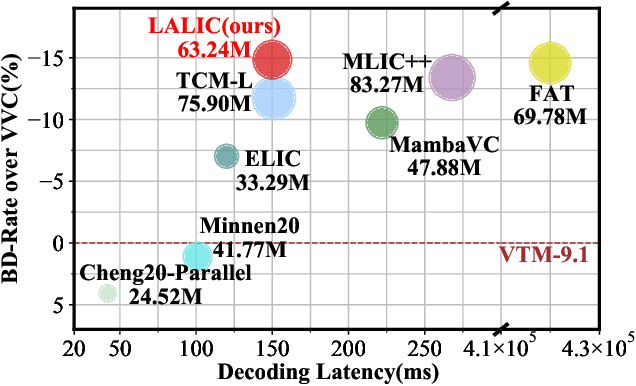



Abstract:Recent years, learned image compression has made tremendous progress to achieve impressive coding efficiency. Its coding gain mainly comes from non-linear neural network-based transform and learnable entropy modeling. However, most of recent focuses have been solely on a strong backbone, and few studies consider the low-complexity design. In this paper, we propose LALIC, a linear attention modeling for learned image compression. Specially, we propose to use Bi-RWKV blocks, by utilizing the Spatial Mix and Channel Mix modules to achieve more compact features extraction, and apply the Conv based Omni-Shift module to adapt to two-dimensional latent representation. Furthermore, we propose a RWKV-based Spatial-Channel ConTeXt model (RWKV-SCCTX), that leverages the Bi-RWKV to modeling the correlation between neighboring features effectively, to further improve the RD performance. To our knowledge, our work is the first work to utilize efficient Bi-RWKV models with linear attention for learned image compression. Experimental results demonstrate that our method achieves competitive RD performances by outperforming VTM-9.1 by -14.84%, -15.20%, -17.32% in BD-rate on Kodak, Tecnick and CLIC Professional validation datasets.
L3TC: Leveraging RWKV for Learned Lossless Low-Complexity Text Compression
Dec 24, 2024
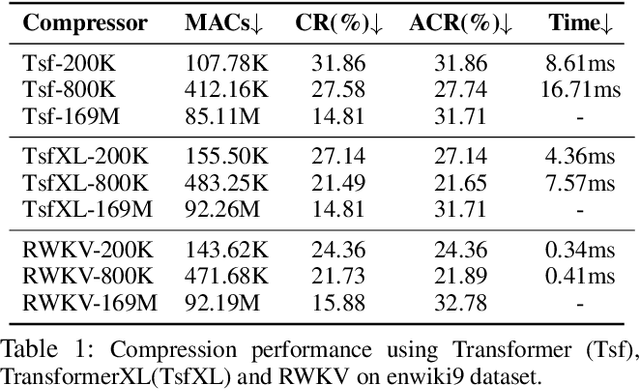


Abstract:Learning-based probabilistic models can be combined with an entropy coder for data compression. However, due to the high complexity of learning-based models, their practical application as text compressors has been largely overlooked. To address this issue, our work focuses on a low-complexity design while maintaining compression performance. We introduce a novel Learned Lossless Low-complexity Text Compression method (L3TC). Specifically, we conduct extensive experiments demonstrating that RWKV models achieve the fastest decoding speed with a moderate compression ratio, making it the most suitable backbone for our method. Second, we propose an outlier-aware tokenizer that uses a limited vocabulary to cover frequent tokens while allowing outliers to bypass the prediction and encoding. Third, we propose a novel high-rank reparameterization strategy that enhances the learning capability during training without increasing complexity during inference. Experimental results validate that our method achieves 48% bit saving compared to gzip compressor. Besides, L3TC offers compression performance comparable to other learned compressors, with a 50x reduction in model parameters. More importantly, L3TC is the fastest among all learned compressors, providing real-time decoding speeds up to megabytes per second. Our code is available at https://github.com/alipay/L3TC-leveraging-rwkv-for-learned-lossless-low-complexity-text-compression.git.
AsymLLIC: Asymmetric Lightweight Learned Image Compression
Dec 23, 2024



Abstract:Learned image compression (LIC) methods often employ symmetrical encoder and decoder architectures, evitably increasing decoding time. However, practical scenarios demand an asymmetric design, where the decoder requires low complexity to cater to diverse low-end devices, while the encoder can accommodate higher complexity to improve coding performance. In this paper, we propose an asymmetric lightweight learned image compression (AsymLLIC) architecture with a novel training scheme, enabling the gradual substitution of complex decoding modules with simpler ones. Building upon this approach, we conduct a comprehensive comparison of different decoder network structures to strike a better trade-off between complexity and compression performance. Experiment results validate the efficiency of our proposed method, which not only achieves comparable performance to VVC but also offers a lightweight decoder with only 51.47 GMACs computation and 19.65M parameters. Furthermore, this design methodology can be easily applied to any LIC models, enabling the practical deployment of LIC techniques.
Controllable Distortion-Perception Tradeoff Through Latent Diffusion for Neural Image Compression
Dec 16, 2024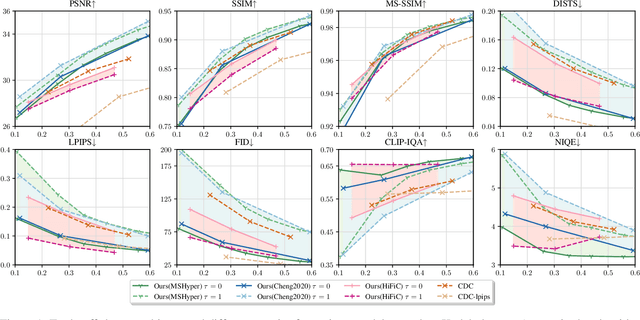

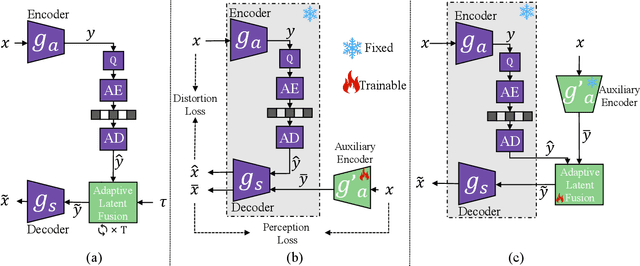

Abstract:Neural image compression often faces a challenging trade-off among rate, distortion and perception. While most existing methods typically focus on either achieving high pixel-level fidelity or optimizing for perceptual metrics, we propose a novel approach that simultaneously addresses both aspects for a fixed neural image codec. Specifically, we introduce a plug-and-play module at the decoder side that leverages a latent diffusion process to transform the decoded features, enhancing either low distortion or high perceptual quality without altering the original image compression codec. Our approach facilitates fusion of original and transformed features without additional training, enabling users to flexibly adjust the balance between distortion and perception during inference. Extensive experimental results demonstrate that our method significantly enhances the pretrained codecs with a wide, adjustable distortion-perception range while maintaining their original compression capabilities. For instance, we can achieve more than 150% improvement in LPIPS-BDRate without sacrificing more than 1 dB in PSNR.
Rate-aware Compression for NeRF-based Volumetric Video
Nov 08, 2024



Abstract:The neural radiance fields (NeRF) have advanced the development of 3D volumetric video technology, but the large data volumes they involve pose significant challenges for storage and transmission. To address these problems, the existing solutions typically compress these NeRF representations after the training stage, leading to a separation between representation training and compression. In this paper, we try to directly learn a compact NeRF representation for volumetric video in the training stage based on the proposed rate-aware compression framework. Specifically, for volumetric video, we use a simple yet effective modeling strategy to reduce temporal redundancy for the NeRF representation. Then, during the training phase, an implicit entropy model is utilized to estimate the bitrate of the NeRF representation. This entropy model is then encoded into the bitstream to assist in the decoding of the NeRF representation. This approach enables precise bitrate estimation, thereby leading to a compact NeRF representation. Furthermore, we propose an adaptive quantization strategy and learn the optimal quantization step for the NeRF representations. Finally, the NeRF representation can be optimized by using the rate-distortion trade-off. Our proposed compression framework can be used for different representations and experimental results demonstrate that our approach significantly reduces the storage size with marginal distortion and achieves state-of-the-art rate-distortion performance for volumetric video on the HumanRF and ReRF datasets. Compared to the previous state-of-the-art method TeTriRF, we achieved an approximately -80% BD-rate on the HumanRF dataset and -60% BD-rate on the ReRF dataset.
R-Bench: Are your Large Multimodal Model Robust to Real-world Corruptions?
Oct 07, 2024

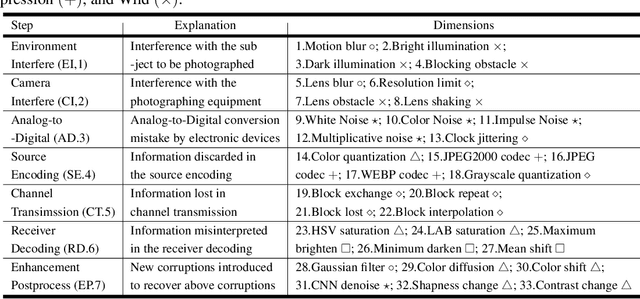

Abstract:The outstanding performance of Large Multimodal Models (LMMs) has made them widely applied in vision-related tasks. However, various corruptions in the real world mean that images will not be as ideal as in simulations, presenting significant challenges for the practical application of LMMs. To address this issue, we introduce R-Bench, a benchmark focused on the **Real-world Robustness of LMMs**. Specifically, we: (a) model the complete link from user capture to LMMs reception, comprising 33 corruption dimensions, including 7 steps according to the corruption sequence, and 7 groups based on low-level attributes; (b) collect reference/distorted image dataset before/after corruption, including 2,970 question-answer pairs with human labeling; (c) propose comprehensive evaluation for absolute/relative robustness and benchmark 20 mainstream LMMs. Results show that while LMMs can correctly handle the original reference images, their performance is not stable when faced with distorted images, and there is a significant gap in robustness compared to the human visual system. We hope that R-Bench will inspire improving the robustness of LMMs, **extending them from experimental simulations to the real-world application**. Check https://q-future.github.io/R-Bench for details.
Free-VSC: Free Semantics from Visual Foundation Models for Unsupervised Video Semantic Compression
Sep 18, 2024



Abstract:Unsupervised video semantic compression (UVSC), i.e., compressing videos to better support various analysis tasks, has recently garnered attention. However, the semantic richness of previous methods remains limited, due to the single semantic learning objective, limited training data, etc. To address this, we propose to boost the UVSC task by absorbing the off-the-shelf rich semantics from VFMs. Specifically, we introduce a VFMs-shared semantic alignment layer, complemented by VFM-specific prompts, to flexibly align semantics between the compressed video and various VFMs. This allows different VFMs to collaboratively build a mutually-enhanced semantic space, guiding the learning of the compression model. Moreover, we introduce a dynamic trajectory-based inter-frame compression scheme, which first estimates the semantic trajectory based on the historical content, and then traverses along the trajectory to predict the future semantics as the coding context. This reduces the overall bitcost of the system, further improving the compression efficiency. Our approach outperforms previous coding methods on three mainstream tasks and six datasets.
S4D: Streaming 4D Real-World Reconstruction with Gaussians and 3D Control Points
Aug 23, 2024Abstract:Recently, the dynamic scene reconstruction using Gaussians has garnered increased interest. Mainstream approaches typically employ a global deformation field to warp a 3D scene in the canonical space. However, the inherently low-frequency nature of implicit neural fields often leads to ineffective representations of complex motions. Moreover, their structural rigidity can hinder adaptation to scenes with varying resolutions and durations. To overcome these challenges, we introduce a novel approach utilizing discrete 3D control points. This method models local rays physically and establishes a motion-decoupling coordinate system, which effectively merges traditional graphics with learnable pipelines for a robust and efficient local 6-degrees-of-freedom (6-DoF) motion representation. Additionally, we have developed a generalized framework that incorporates our control points with Gaussians. Starting from an initial 3D reconstruction, our workflow decomposes the streaming 4D real-world reconstruction into four independent submodules: 3D segmentation, 3D control points generation, object-wise motion manipulation, and residual compensation. Our experiments demonstrate that this method outperforms existing state-of-the-art 4D Gaussian Splatting techniques on both the Neu3DV and CMU-Panoptic datasets. Our approach also significantly accelerates training, with the optimization of our 3D control points achievable within just 2 seconds per frame on a single NVIDIA 4070 GPU.
 Add to Chrome
Add to Chrome Add to Firefox
Add to Firefox Add to Edge
Add to Edge